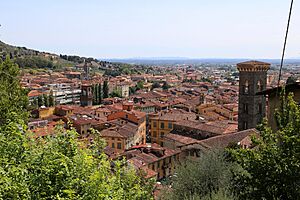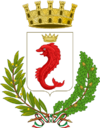Pescia facts for kids
Quick facts for kids
Pescia
|
||
|---|---|---|
| Comune di Pescia | ||
 |
||
|
||
| Country | Italy | |
| Region | Tuscany | |
| Province | Pistoia (PT) | |
| Frazioni | Medicina, Fibbialla, Aramo, San Quirico, Castelvecchio, Stiappa, Pontito, Sorana, Vellano, Pietrabuona, Collodi, Veneri, Chiodo | |
| Area | ||
| • Total | 79.18 km2 (30.57 sq mi) | |
| Elevation | 68 m (223 ft) | |
| Population
(31 December 2017)
|
||
| • Total | 19,584 | |
| • Density | 247.335/km2 (640.60/sq mi) | |
| Demonym(s) | Pesciatini | |
| Time zone | UTC+1 (CET) | |
| • Summer (DST) | UTC+2 (CEST) | |
| Postal code |
51017, 51012, 51010
|
|
| Dialing code | 0572 | |
| Patron saint | St. Dorothea | |
| Saint day | 6 February | |
Pescia is a city in central Italy. It is located in the Tuscany region, in the province of Pistoia.
The city sits between the famous cities of Lucca and Florence. It is built along the banks of a river that shares its name.
Contents
History of Pescia
Early Beginnings
Archaeologists believe the first settlement in Pescia was built by the Lombards. They were a Germanic people who ruled parts of Italy long ago. The name "Pescia" actually comes from a Lombard word, pehhia, which means "river". This makes sense since the city is right by a river!
Medieval Times and Conflicts
In the 1200s, the city of Lucca attacked and destroyed Pescia. But the people quickly rebuilt it. For many years during the Middle Ages, Pescia was caught between two powerful rivals: Florence and Lucca. The city was right on their border. In 1339, after nearly ten years of fighting, Florence finally took control of Pescia.
Economy and Changes Over Time
For a long time, Pescia's economy relied on growing mulberry trees and raising silkworms. This was important for making silk. The city faced a tough time during the Black Death in the 1300s, which caused a big drop in population and economic activity. Things only started to get better by the late 1400s.
By the end of the 1600s, the leader of Tuscany declared Pescia a "City of the Grand Duchy of Tuscany." In the 1800s, silk production was so big that Pescia was called "the little Manchester of Tuscany." Manchester was a famous industrial city in England. However, the city's economy suffered after a trade disagreement between France and Italy in 1888. When Napoleon came through, he also hurt the silk industry by promoting sugar beet instead.
Since 1925, Pescia has found new ways to make money. People started growing and selling flowers, especially carnations, and olive plants. Sadly, the city was badly damaged by bombs during World War II.
Main Sights to See
- Palazzo del Vicario: This building from the 1200s–1300s is now the Town Hall.
- Palazzo Palagio: Also known as del Podestà, this old palace dates back to the 1100s–1200s.
- Pescia Cathedral: This church might have been built as early as the 400s or 500s. It has been rebuilt many times. The oldest parts you can see today are from the 1200s.
- San Francesco: This is a Gothic church from the 1200s. It has beautiful artworks, including a fresco by Neri di Bicci from 1458. There's also a famous painting of St. Francis and the Episodes of His Life from 1235 by Bonaventura Berlinghieri. It's one of the earliest pictures of St. Francis!
- Communal Palace: Another important historic building in the city.
- City Library: A place for books and learning.
- Old Flower Market: Built in 1951, this building is known for its interesting modern architecture.
- Madonna di Piè di Piazza: A small, beautiful chapel built in the Renaissance style.
Economy
Today, Pescia is a major center for growing and selling flowers, especially carnations. It's an international market for them! The city also produces a lot of paper.
The nearby village of Sorana is famous for its special sorana bean.
Education
Pescia has several high schools. There are schools focused on subjects like economics, farming, and graphic design. There are also schools for cultural studies, including classical subjects, science, languages, and psychology.
Museums
- Paper Museum in Pescia
- Municipal Museum
- Gipsoteca Libero Andreotti
- Pinacoteca di San Michele
Twin Cities
Pescia has "twin city" relationships with:
 Nerja, Spain
Nerja, Spain Oullins, France
Oullins, France
See also
 In Spanish: Pescia para niños
In Spanish: Pescia para niños


